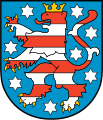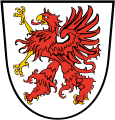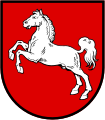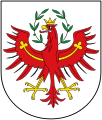Heraldic animal
Heraldic animal is a type of animal that is represented in a coat of arms as a common figure , as a shield holder or as a helmet ornament . The term heraldic animal is not used by heraldists , but is very popular with laypeople.
The common character heraldic animal

All animals of the natural animal kingdom and animals from the mythical world ( unicorn , dragon , griffin, etc.) can be used in the coat of arms . The modification of known living beings through seemingly absurd changes has enriched heraldry. For example, mammals with fish tails ( sea lions ) or animals with wings (winged bulls ) that are not made for flying are special features.
With a few exceptions, the animals are stylized in the coat of arms. The animals in particular, which found their place on shields in the early days of heraldry, have been adapted to fashion over the centuries, and their representation is artistically permeated. The historian can assign the type of representation to the respective epoch. Most heraldic animals have a privileged position in the shield. Many heraldic animals look to the right (from the point of view of the shield-bearer) and lions are shown primarily rising. This simplifies the description of the coat of arms ( blazon ), because the basic positions do not need to be mentioned. The heraldic animals can be growing, standing at the crack, crowned or even capped (armor over the head). Many terms aptly explain the appearance, position and color in short form.
Many heraldic animals only take parts such as the head, wings, feet and front part. These are treated like the whole animal. The description of the reinforcement makes the slight difference between two apparently identical coats of arms.
Heraldic animals remain a mean figure even if they touch the edge of the shield or a dividing line in the shield.
Popular heraldic animals are eagles , lions , leopards and mythical animals .
The reptiles are to be counted among the less common animals. Reptiles are a common figure in heraldry as a heraldic animal. All kinds of lizards, such as crocodiles, lizards and salamanders, as well as snakes and turtles, can be found in the coats of arms and are the most important representatives. Each of these animal species has its own rules for the representation in shield or coat of arms, or as a shield holder.
- Crocodile: see main article crocodile (heraldic animal)
- Snake: see main article Snake (heraldic animal)
- Salamander: see main article Salamander (heraldic animal)
- Lizard: The representation is mainly in the plan view.
- Turtle: see main article turtle (heraldic animal)
- see main article of the desired heraldic animal
- Insects: Insects are also included among the less common animals. See main article bees and ants . For the other insects see under common figure, section insects .
Heraldic animal with fish tail
In the case of many heraldic animals, the rear part is replaced by a fish tail. This doubles the possibilities in or above the coat of arms. There are no limits to your imagination. A church ceiling shows what is possible. In the church of St. Martin Zillis many mythical creatures , which are also used in heraldry, are depicted on the ceiling . The special feature is the very extensive representation of heraldic animals with a fish tail. For example, lion, boar, unicorn, billy goat, ram and wolf with fish tails are depicted. Even an elephant is represented like this. In heraldry, this is emblazoned with fish-tailed . Human beings also belong to it. Examples are Triton and the Melusine , also known as the mermaid .
- See also fish griffin .
application
While in heraldry the representation elements in the shield are basically arbitrary, i.e. can be freely chosen by the coat of arms owner, there has been a tendency to associate a certain symbolism with a common figure since the early days of heraldry.
In heraldry - as far as possible - talking coats of arms are welcome. This means that the coat of arms designers should definitely follow the name of the coat of arms owner when designing the coat of arms. This striving can also produce many animal motifs, for example in family names such as “deer”, “fisherman”, “boar” etc.
Use of the heraldic animals in the Prussian coat of arms
In the large coat of arms of the German emperors as kings of Prussia and in the middle coat of arms, these heraldic animals are shown in the fields (without gems and upper coat of arms ):
- Large coat of arms of the German emperors as kings of Prussia
- middle coat of arms Wilhelm II as King of Prussia
- Adler six times
- Leo five times
- Horse twice
- Grab once.
The scattered individual states show in the compilation in the Prussian coat of arms only the frequency of the chosen heraldic animals and thus document their popularity.
Heraldic animals of the German states
Heraldic animals are used in most of the coats of arms of the German states .
- Baden-Württemberg : various lions ( Staufer lion, Palatinate lion )
- Bavaria : various lions ( Palatinate lion ) and blue panthers
- Berlin : Bear ( Berlin Bear )
- Brandenburg : Adler ( Märkischer Adler )
- Hessen : lion (" colorful lion ")
- Mecklenburg-Western Pomerania : Stier ( Mecklenburg ) and Greif ( Western Pomerania )
- Lower Saxony : horse ( Sachsenross )
- North Rhine-Westphalia : Westphalia horse
- Rhineland-Palatinate : Palatinate Lion
- Saarland : various lions ( Palatinate lion ) and eagles
- Saxony-Anhalt : bear and eagle
- Schleswig-Holstein : Leuven ( Schleswig )
- Thuringia : Lion (" Colorful Lion ")
The colorful lion of Hesse
The Colorful Lion of Thuringia
The Berlin bear
The Saxon horse
The Palatinate Lion
The Märkische Adler
The Staufer Lions
The blue panther
In Bavaria , Bremen and Hamburg two lions, in Baden-Württemberg deer and griffin are part of the coat of arms as shield holders .
Heraldic animals of the Austrian countries
- Burgenland : Red Eagle
- Carinthia : three lions
- Lower Austria : five eagles or larks
- Upper Austria : eagle
- Salzburg : lion
- Styria : The Styrian Panther
- Tyrol : Tyrolean eagle
- Vorarlberg
- Vienna : eagle
The Tyrolean eagle
Heraldic animals of the Swiss cantons
- Appenzell : Bear
- Bern : Bear
- Geneva : eagle
- Graubünden : Capricorn
- Schaffhausen : ram
- Thurgau : Two lions
- Uri : Uristier
See also
literature
- ^ Ernst Murbach: Zillis. The Romanesque picture ceiling of the Church of St. Martin . Photographed and edited by Peter Heman. Atlantis-Verlag, Zurich et al. 1967.























